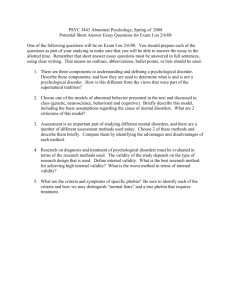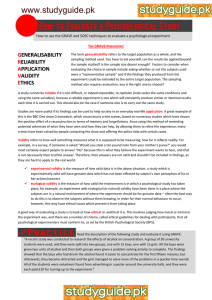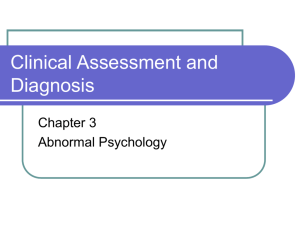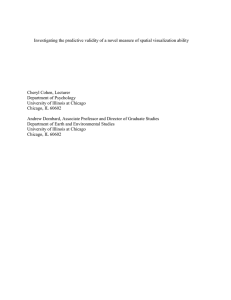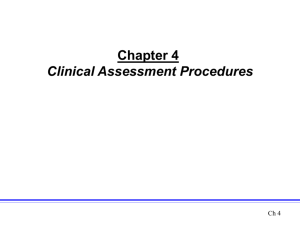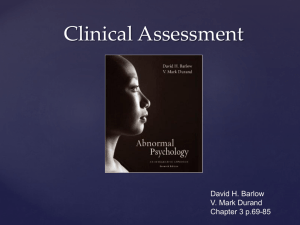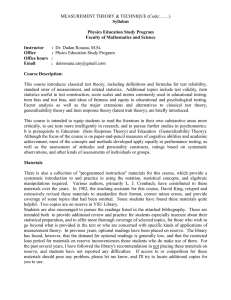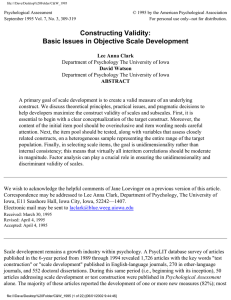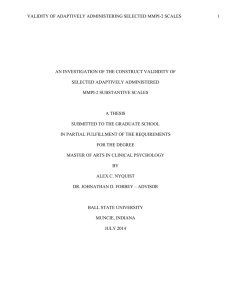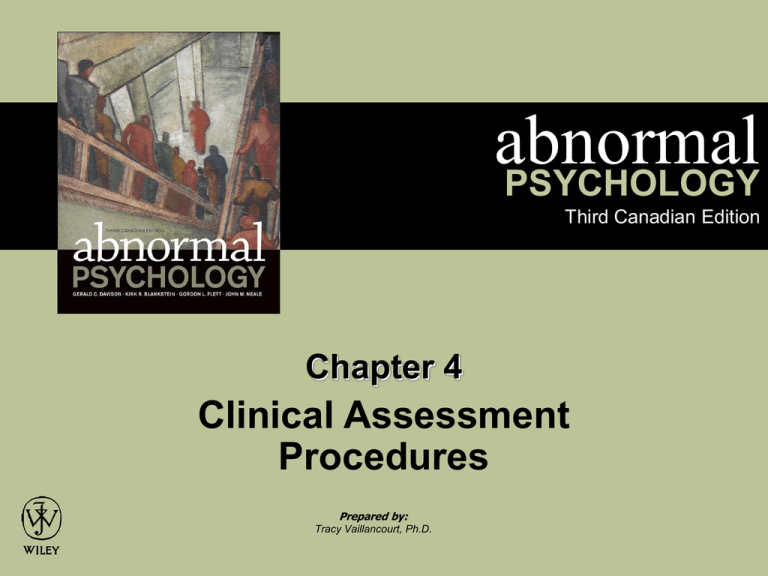
abnormal
PSYCHOLOGY
Third Canadian Edition
Chapter 4
Clinical Assessment
Procedures
Prepared by:
Tracy Vaillancourt, Ph.D.
Reliability and Validity in
Assessment
• Reliability
– Inter-rater reliability
– Test–retest reliability
– Alternate-form
reliability
– Internal consistency
reliability
• Validity
– Content validity
– Criterion validity
– Construct validity
Psychological Assessment
• Clinical Interview
• Structured Interview
• Psychological Tests
– standardized procedures
designed to measure
person’s performance on a
particular task or to assess
personality, or thoughts,
feelings, and behaviour
• Examples
• Personality Inventories
– MMPI-2
• Projective Personality
Tests
– Rorschach Inkblot Test
– Thematic Apperception
Test (TAT)
• Intelligence Tests
MMPI-2
Behavioural and Cognitive
Assessment
• Often a system that involves the assessment of
four sets of variables, is used (SORC)
– S refers to stimuli
• the environmental situations that precede the problem
– O refers to organismic
• physiologicaland psychological factors assumed to be
operating “under the skin
– R refers to overt responses
– C refers to consequent variables
• events that appear to be reinforcing or punishing the
behaviour in question
Assessment cont.
• Observational Methods
– Direct Observation of Behaviour
– Self-Observation
• Self-monitoring
• Ecological momentary assessment
• Interview
• Self-Report Inventories
• Family Assessment
Summary of Psychological
Assessment Methods
Biological Assessment
Brain Imaging
• Computerized axial tomography (CT scan)
– moving beam of X-rays passes into a horizontal
cross-section of brain, scanning it through 360
degrees
– moving X-ray detector on the other side measures
amount of radioactivity that penetrate thus detecting
subtle differences in tissue density
– computer uses information to construct a twodimensional, detailed image of the cross-section
Biological Assessment cont.
• Magnetic resonance imaging (MRI)
– superior to the CT scan because produces pictures of
higher quality and does not rely on radiation required
by CT scan
– circular magnet causes the hydrogen atoms in the
body to move
– when magnetic force is turned off, the atoms return to
their original positions and thereby produce an
electromagnetic signal
– signals are then read by the computer and translated
into pictures of brain tissue
Biological Assessment cont.
• Positron emission tomography (PET scan)
– more expensive and invasive procedure
– allows measurement of brain function
– brain is labelled with a short-lived radioactive isotope and injected in
bloodstream
– radioactive molecules of the substance emit a positron which collides
with an electron
– pair of high-energy light particles shoot out from the skull in opposite
directions and are detected by the scanner
– computer analyzes millions of such recordings and converts them into a
picture of the functioning brain
• Neurochemical Assessment
– Example— analyzing the metabolites of neurotransmitters that have been
broken down by enzymes
Brain Imaging
Neuropsychological Assessment
• Neuropsychological tests— based on the
idea that different psychological functions
are localized in different areas of the brain.
• Halstead-Reitan Battery
– 1. Tactile Performance Test—Time
– 2. Tactile Performance Test—Memory
– 3. Category Test
– 4. Speech Sounds Perception Test
• Luria-Nebraska Battery
Psychophysiological Assessment
• Activities of the autonomic nervous system are
frequently assessed by electrical and chemical
measurements in attempt to understand the
nature of emotion.
– Heart rate measured with electrocardiogram
– Skin conductance measured with electrodermal
responding
– Brain activity measured by electroencephalogram
(EEG)
Summary of
Biological Assessment Methods
Cultural Diversity and Clinical
Assessment
• Cultural Bias in Assessment
• Strategies to Avoid Cultural Biases in
Assessment
– Example language, Canadian norms, etc.
Copyright
Copyright © 2008 John Wiley & Sons Canada, Ltd. All rights
reserved. Reproduction or translation of this work beyond that
permitted by Access Copyright (The Canadian Copyright
Licensing Agency) is unlawful. Requests for further information
should be addressed to the Permissions Department, John
Wiley & Sons Canada, Ltd. The purchaser may make back-up
copies for his or her own use only and not for distribution or
resale. The author and the publisher assume no responsibility
for errors, omissions, or damages caused by the use of these
programs or from the use of the information contained herein.

